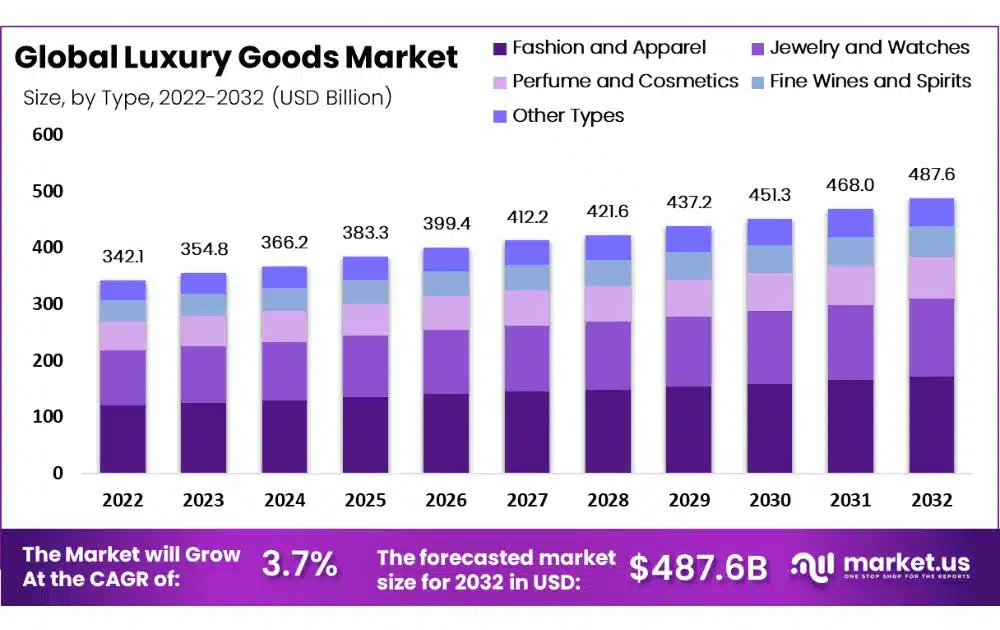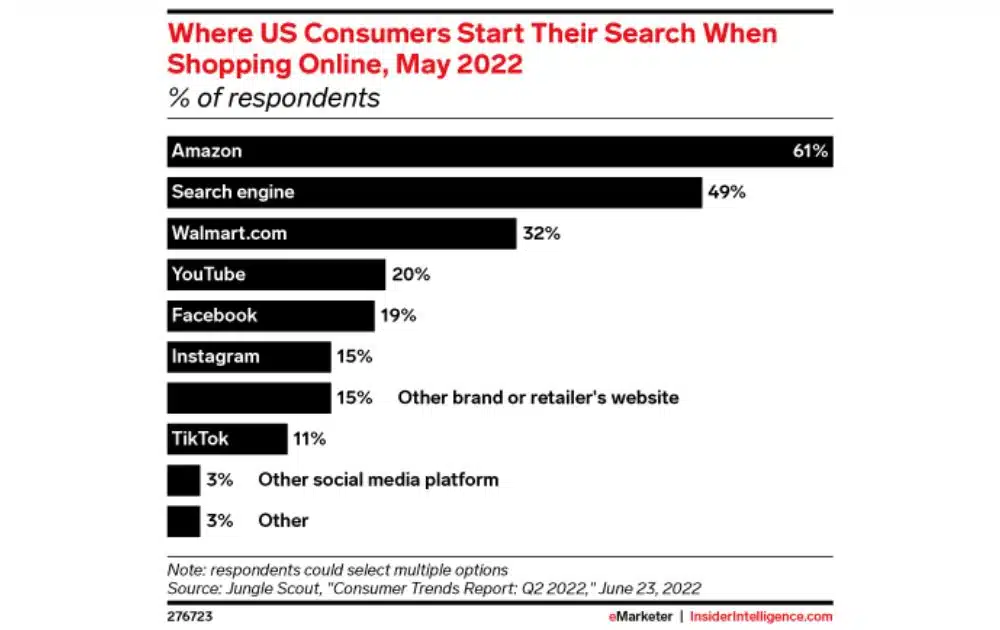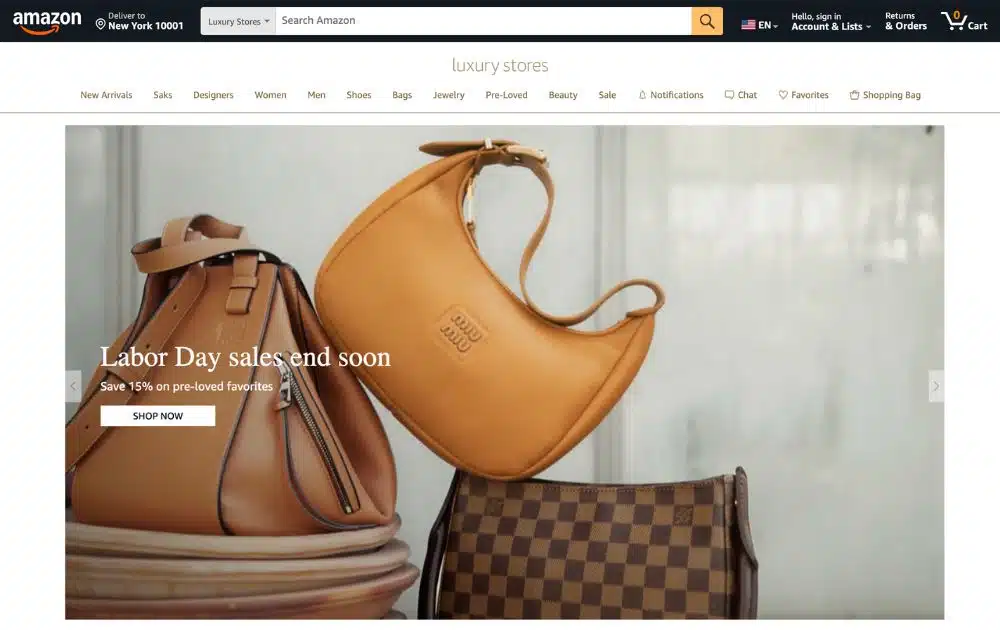Selling High-End Apparel Brands on Amazon
Learn why premium apparel brands should harness the power of Amazon as a sales channel, without diluting brand value.
The global luxury goods market hit $342.1 billion in 2022 and is projected to climb to $487.6 billion by 2032, growing at a steady 3.7% CAGR. A large portion of that growth comes from fashion and apparel, which continue to dominate the sector.

For high-end labels and even 8-figure sellers, the question is no longer if consumers will buy premium pieces online; it’s how to preserve brand value while selling on digital platforms.
The top apparel brands aren’t just chasing trends or runways anymore. These days, the game revolves around chasing customers where they already shop, including Amazon.
Why Should Apparel Brands Sell on Amazon
Gone are the days when the growth of high-end apparel brands was confined to boutiques, flagship stores, or even standalone eCommerce sites. Online shopping trips often kick off on Amazon, making it the primary entry point.
In fact, 61% of U.S. consumers begin their product search on Amazon, compared to 49% who start on traditional search engines. That means before potential buyers even type a brand name into Google, they’re often browsing through Amazon.

This shift underscores Amazon’s role as both a search engine and a shopping destination rolled into one. For executives managing premium apparel brands, ignoring Amazon means potentially missing out on the majority of first impressions in the customer journey.
At the same time, Amazon has elevated its presence beyond basics and mass-market labels. The platform now offers a curated environment where high-end and designer brands can showcase their products with the exclusivity and storytelling they’re used to deliver in luxury retail.
Amazon Luxury is designed to allow users to tap into Amazon’s vast reach while protecting brand value through the following capabilities:
- Custom storefronts
- Elevated imagery
- Immersive shopping features
Amazon Fashion and Amazon Luxury
Apparel sellers can showcase their products through two Amazon marketplaces: Amazon Fashion and Amazon Luxury Stores. Each serves a different purpose, yet both provide powerful opportunities for growth.
Amazon Fashion Store
The Amazon Fashion Store is the broader marketplace where shoppers can find everything from everyday wear to mid-tier labels. It’s accessible to a wide range of sellers, making it a prime space for emerging apparel brands looking to gain visibility alongside household names.
Notable features you’ll find in the Amazon Fashion Store include:
- Wide product range. Includes clothing, shoes, accessories, and seasonal collections from a mix of everyday and premium apparel brands.
- Search and filter tools. Advanced filters by size, color, style, price, and brand help customers narrow down choices quickly.
- Prime benefits. Fast, free shipping and easy returns through Amazon Prime make purchasing apparel risk-free.
- Personalized recommendations. AI-driven suggestions based on browsing and purchase history increase product visibility for sellers.
- Customer reviews and ratings. Authentic buyer feedback builds trust and influences purchasing decisions.
Amazon Luxury Stores
Meanwhile, Amazon Luxury focuses on a narrower, more exclusive circle. This invite-only program is designed to highlight designer brands on Amazon, offering them a digital storefront that mirrors the exclusivity of a high-end boutique.

Sellers on Amazon Luxury Stores can enjoy the following features:
- Custom brand storefronts. Fully branded digital “boutiques” that replicate the feel of high-end retail spaces.
- Immersive shopping experience. 360-degree product views, rich media, and editorial-style layouts that showcase collections with storytelling.
- Enhanced brand control. Greater say over pricing, product presentation, and customer experience compared to the standard Amazon Fashion Store.
- Limited Distribution. Designed to preserve exclusivity, preventing brand dilution in a mass-market setting.
- Exclusive content options. Professional images, videos, and stylized visuals that bring out craftsmanship and luxury appeal.
How to Sell High-End Apparel Brands on Amazon
Both Amazon Luxury and Amazon Fashion Store illustrate how Amazon is now more than a marketplace for basics.
Here’s a guide for those looking to sell their premium apparel brands on the platform:
Audit brand readiness
Clarify your positioning, price architecture, hero SKUs, and channel rules. Doing so will allow you to analyze the alignment of your brand with the marketplace.
Choose your selling model
Default to Seller Central (3P) for control and margins. If you’re invited to 1P (Vendor Central), weigh scale vs control carefully.
Lock down IP & identifiers
Secure a registered trademark, clean product naming conventions, and GS1 barcodes. This makes Brand Registry and catalog integrity smoother.
Enroll in Brand Registry
Unlock A+ Content, Stores, Brand Analytics, and better counterfeit protections. These Amazon Brand Registry features are non-negotiable for premium apparel brands.
Define the Amazon assortment
Curate your Amazon assortment (core styles, limited capsules, or Amazon-only colorways) to prevent channel overlap. Additionally, enforce the MAP policy with a short, vetted reseller list to ensure pricing and presentation remain premium.
Choose your fulfillment strategy
You have several fulfillment strategies to choose from:
- Fulfillment by Amazon (FBA) for Prime speed and conversion lift.
- Fulfilled by Merchant (FBM) if you need white-glove packaging or bespoke inserts. If you’re choosing this option, ensure luxury-grade packaging to preserve brand value. After all, data reveals that 6 out of 10 shoppers are likely to buy from a brand again if they had a premium unboxing experience.

Build premium product pages
Make sure that your titles, bullets, and descriptions reflect the brand voice. For your image stacks, use model shots, detail macros, fabric textures, care labels, true-to-life color.
Create a branded Amazon Store
Design a boutique-like Amazon store with seasonal landing pages, shoppable lookbooks, and editorial sections.
Launch with a controlled media plan
Roll out your ads in phases to protect price integrity and fund what’s working while killing what isn’t. You can start with:
- Sponsored Brands designed for top-of-funnel visibility.
- Sponsored Products to win high-intent queries.
Build social proof responsibly
Enroll eligible SKUs in Amazon Vine, encourage authentic reviews via “Request a Review,” and use Brand Customer Service to resolve fit and quality issues quickly.
Strategies for Maintaining Brand Value on Amazon
Here are a few strategies to implement when selling high-end apparel brands on Amazon:
Curate your Amazon assortment
List core heroes, which are our proven, high-volume styles. For instance, this could be your signature linen shirt, a classic tee, or black ankle trousers. Because they convert reliably, they can anchor your brand search and train the algorithm.
In addition, you can also offer Amazon-exclusive colorways. These items are top performers in color options sold solely through Amazon. For instance, your linen shirt in Sage and Terracotta that are exclusive to Amazon. Doing so offers the following benefits:
- Differentiate your Amazon store from your site or boutiques
- Reduce channel conflict
- Give Amazon a “reason to exist” for loyal fans
Hold the line on pricing
Maintaining stable prices ensures that premium apparel brands preserve their perceived value. If customers see your pieces discounted or yo-yo priced on Amazon, they’ll anchor to the lowest number and wait for deals. Unstable pricing can lead to:
- Erosion of brand equity
- Anger shoppers at your boutiques or stores with higher pricing
- Spark a race to the bottom with resellers
That said, it’s crucial to set and enforce a MAP policy, mirror pricing across channels, and avoid blanket coupons. Instead of discounts, use bundles or gift-with-purchase to protect perceived value.
Own your presentation
If you’re a premium label, treat Amazon like a digital flagship, not a clearance aisle. For apparel labels, this calls for meticulous management of how your brand story, imagery, and product information appear everywhere.
Here are several Amazon features designed to support your brand:
- Enroll in Brand Registry. If your trademark isn’t registered yet, kick it off through IP Accelerator so you can get access sooner. After joining, register your ASINs, define team or agency roles, and activate the protection settings.
- Build your brand store as a true digital boutique. Create a homepage and a handful of collection pages (think Core, Capsule, New Arrivals, and Accessories). Merchandise them with shoppable lookbooks and concise editorial about craftsmanship or sustainability.
- Publish A+ Content on your top sellers to turn product pages into conversion engines. Explain fabric and construction, show close-up detail, clarify fit and care, and add a short brand story across the catalog for consistency.
If you need help building a solid presence on Amazon, reach out to us! As trusted consultants for global brands, we can help you manage your ecommerce strategy so that every effort brings optimum results.
The Lowdown
For upscale apparel brands, the strategy lies in maximizing Amazon’s exposure while keeping the label exclusive. Treat Amazon Fashion Store like your scalable storefront and view Amazon Luxury Stores as your digital flagship; each has a role in your mix.
Through curation, pricing discipline, and luxury-grade storytelling, you can stand out among designer brands on Amazon while protecting what matters most: your brand’s value.
Author
 Carla Bauto Deña is a journalist and content writer producing stories for traditional and digital media. She believes in empowering small businesses with the help of innovative solutions, such as ecommerce, digital marketing, and data analytics.
Carla Bauto Deña is a journalist and content writer producing stories for traditional and digital media. She believes in empowering small businesses with the help of innovative solutions, such as ecommerce, digital marketing, and data analytics.
The post Selling High-End Apparel Brands on Amazon appeared first on AMZ Advisers.


